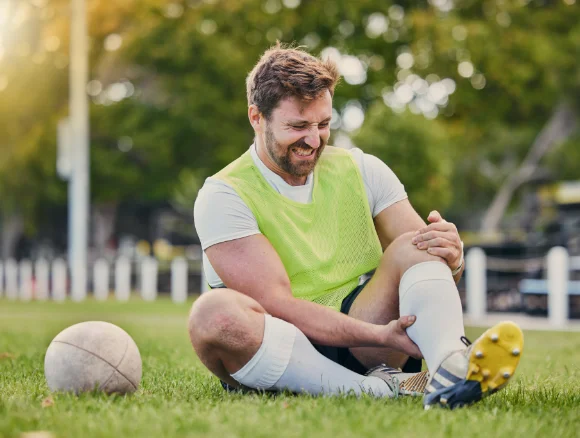Sports Injuries
Expert Orthopaedic Care by Dr Blake Fidock at Ortho Arc Brisbane
Understanding Sports Injuries
Engaging in sports and physical activities is essential for maintaining overall health and fitness. However, sports injuries are common and can affect anyone from amateur athletes to professionals. These injuries can range from minor strains and sprains to more serious fractures, ligament tears, and joint dislocations. Proper diagnosis and treatment are essential for effective recovery and long-term performance.
Dr Blake Fidock, an experienced orthopaedic surgeon at Ortho Arc in Brisbane, specialises in managing trauma, hip, knee, foot, and ankle conditions, including sports-related injuries. Whether you have sustained an acute injury or are dealing with a chronic condition due to repetitive stress, Dr Fidock provides expert care tailored to your needs.

Common Types of Sports Injuries
Sports injuries can vary in severity and affect different parts of the body. Some of the most common sports injuries include:
Lower Limb Injuries
- Ankle Sprains and Fractures – Sudden twists, missteps, or direct impact can cause ligament damage or fractures in the ankle.
- Knee Ligament Injuries (ACL, MCL, PCL Tears) – Sudden changes in direction or impact can lead to tears in the anterior cruciate ligament (ACL) and other knee ligaments.
- Meniscus Tears – Common in sports that involve squatting, twisting, or sudden stops, meniscus injuries can cause knee pain and swelling.
- Achilles Tendon Injuries – Repetitive stress or sudden forceful movements can lead to tendonitis or even rupture of the Achilles tendon.
Upper Limb Injuries
- Shoulder Dislocations and Rotator Cuff Tears – Frequent in contact sports or overhead activities such as rugby, swimming, and tennis.
- Fractures in the Arm, Wrist, and Collarbone – Falls or direct impacts often result in broken bones in the upper extremities.
Overuse and Chronic Injuries
- Shin Splints – Common in runners, caused by excessive stress on the shinbone and surrounding muscles.
- Tendinitis (e.g., Patellar Tendinitis, Tennis Elbow) – Repetitive movements lead to inflammation of tendons in various joints.
- Stress Fractures – Often caused by repetitive impact in sports like running, basketball, and gymnastics.
Causes and Risk Factors
Sports injuries can occur due to various factors, including:
- Improper training techniques – Poor form or incorrect execution of exercises can lead to strain and injury.
- Inadequate warm-up and stretching – Skipping proper warm-up increase the risk of muscle stiffness and ligament damage.
- Overuse and repetitive stress – Engaging in the same motions repeatedly without adequate rest can lead to chronic injuries.
- Sudden impacts or falls – Contact sports and high-impact activities increase the risk of fractures and dislocations.
- Poor footwear and equipment – Using inappropriate shoes or equipment can contribute to imbalances and injuries.

About Dr Blake Fidock
MBBS (Hons. 1), MTrauma (Ortho), FRACS (Ortho), FAOrthA
Orthopaedic Surgeon
Treatment Options for Sports Injuries
Dr Blake Fidock offers a comprehensive range of treatment options, from conservative approaches to advanced surgical solutions, depending on the severity and type of injury.
Non-Surgical Treatments
For many sports injuries, conservative treatments can effectively manage pain and promote healing:
- Rest and Activity Modification – Avoiding activities that aggravate the injury allows for proper healing.
- Physical Therapy and Rehabilitation – Strengthening exercises and mobility training help restore function and prevent future injuries.
- Bracing and Supportive Devices – Using braces or orthotic inserts can stabilise and support injured areas.
- Medications and Pain Management – Anti-inflammatory drugs help reduce pain and swelling.
- Corticosteroid Injections – In some cases, injections can provide temporary relief from inflammation and pain.
Surgical Treatments
For severe injuries that do not respond to conservative treatments, Dr Fidock may recommend surgical intervention, including:
- Arthroscopic Surgery – Minimally invasive procedures to repair ligaments, tendons, or cartilage damage.
- Ligament Reconstruction (e.g., ACL Reconstruction) – Restoring stability to the knee after severe ligament tears.
- Fracture Fixation – Using plates, screws, or rods to stabilise broken bones and ensure proper healing.
- Tendon Repair or Reconstruction – Surgical treatment for ruptured tendons, such as Achilles tendon repair.
When to See Dr Blake Fidock for a Sports Injury
If you experience any of the following symptoms, seeking expert orthopaedic care is crucial:
- Persistent pain, swelling, or stiffness that does not improve with rest.
- Limited range of motion or instability in the affected joint.
- Difficulty bearing weight or performing regular activities due to pain.
- Visible deformities or signs of severe trauma, such as fractures or dislocations.
- Chronic pain from a previous sports injury that is affecting performance.
Why Choose Dr Blake Fidock at Ortho Arc in Brisbane?
Dr Blake Fidock is a highly skilled orthopaedic surgeon with extensive experience in sports injury management, trauma care, and joint reconstruction. His expertise in treating foot, ankle, knee, and hip conditions ensures that athletes receive the best possible care to restore function and prevent long-term complications.
At Ortho Arc in Brisbane, Dr Fidock utilises cutting-edge diagnostic techniques and personalised treatment plans to help patients recover quickly and safely. Whether you are a professional athlete or a weekend warrior, he is dedicated to helping you get back to your sport stronger and pain-free.
Request a Referral and Book an Appointment
If a sports injury is affecting your mobility and performance, don’t delay seeking expert care.